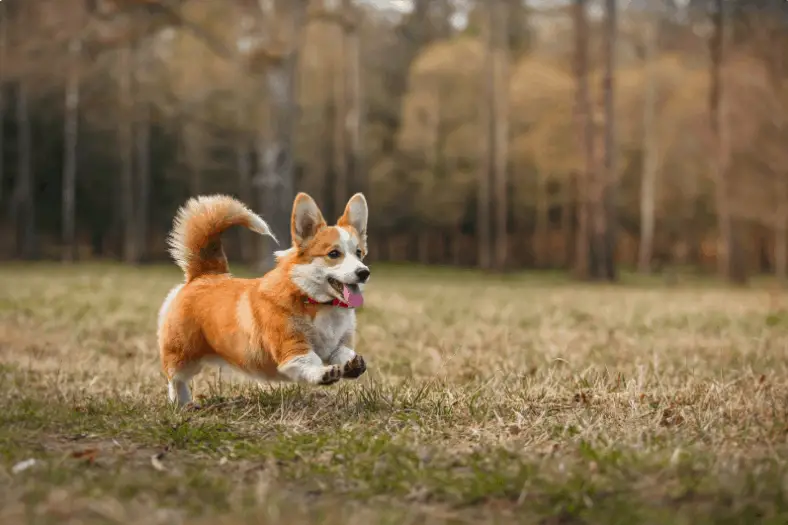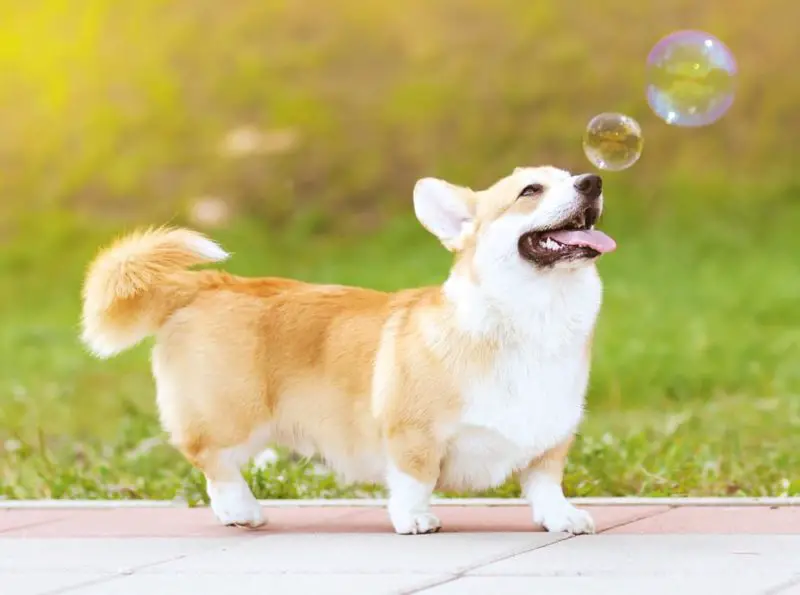Do Corgis have tails?
Yes, Pembroke Welsh Corgis are born with tails. One of the most distinguishing features of the Pembroke Welsh Corgi is its stubby tail. But did you know that Pembroke Welsh Corgis are born with long tails? It’s true! However, because of their breed standard, many have their tails docked 2 to 5 days after birth.
Natural bobtailed Corgis (born with very short tails) do exist, but they’re not nearly as common. On the other hand, Cardigan Welsh Corgis almost always retain their tails, as tails are part of their breed standard. So, if you’re ever wondering why some Corgis have tails and others don’t, now you know!

Are Corgi’s tails docked?
Pembroke Welsh Corgis are a popular breed of dog, known for their stubby legs and long body. According to the American Kennel Club, they should also have a docked tail. The tail should be docked as short as possible without creating an indentation in the tail region. This is to conform to the breed standard set by the AKC.
Some people believe that docking a dog’s tail is cruel, but it is a humane practice if done correctly. Tail docking is typically done when the puppy is around two days old, and it only takes a few seconds to complete. After the procedure, the puppy will heal quickly and will not experience any long-term effects.
Although, many Corgi owners are beginning to defy the rules and do not accept that their puppies’ tails get docked. The results of these are Corgis with long, furry tails, some Corgis grow tails that look like the ones of red foxes and are fascinating to watch.
Why do they cut Corgi tails?
The breeders of Pembroke Welsh Corgis cut the tails of these dogs to conform to the breed standards imposed by kennel clubs such as the American Kennel Club or the Kennel Club of England, these organizations determine the appearance that the breeds should have. In the case of Pembroke Corgis, the standard says that their tails should be as short as possible without being indented.
This is mainly because the Pembroke Corgis were created for herding work and their natural tails were a hindrance, and it was necessary to cut them so that the dog could fulfill its functions. Perhaps the concern was that the sheep could step on the tail of the dog and cause harm, so the best thing for the well-being of the dog is that it does not have a tail.
However, this theory does not make much sense if we look at the breed standard of the Cardigan Welsh Corgi. Cardigan Corgis were created to fulfill the same herding functions, but these dogs do not have their tails docked. So it seems that cardigan Corgis tails are cut off for aesthetic reasons.

Why do breeders dock the tails of Corgi puppies?
This practice of breeders docking tails of Corgis is related to this expectation of the breed standard and because of the heritage of the animal. The idea here is that this working dog would be impeded if it had a long tail.
There are concerns that it could get in the way or even become injured as the dog runs around the land herding livestock. Ranch owners may see the benefits in docking these tails and that they are doing both themselves and the animal a favor in the long run.
In addition to this, some breeders now look to create litters with naturally shorter tails. Some dogs have shorter tails than others. Breeding two of these short-tailed Corgis together would, therefore, increase the likelihood of a shorter tail in the pups. Still, it isn’t necessarily going to be as short as 2 inches, so docking may still be necessary.

How are Corgi’s tails docked?
The procedure for tail docking for Corgis is the same as for other breeds. The procedure is performed when the puppy is less than 14 days old and must be conducted by a veterinarian. This consists of measuring the specified length in which the tail should be cut, in the case of Corgis it is 2 inches. The vet then cuts between the tail vertebrae and places absorbable stitches to help the wound heal.
This procedure is controversial because it is usually performed without anesthesia, which is considered inhumane by many people the American Veterinary Medical Association (AVMA) and the Royal College of Veterinary Surgeons (RCVS) oppose this procedure and consider it to be unnecessary. In 2007 this practice was banned in Wales and England, except for working dogs, and is also allowed for medical reasons. While in Scotland it is only allowed for medical reasons. Many other European countries have adopted similar laws.
Why is Corgi tail docking so controversial?
The biggest concern with tail docking, regardless of the breed, is that it subjects the animal to unnecessary harm. The idea of docking a tail for an old-fashioned breed standard doesn’t sit well with those getting Corgis as family pets. They see photos of Corgis with tails and realize what their pet is missing out on.
While there is a risk of tail injuries in the case of working dogs, some feel that this argument for tail docking makes no sense for family dogs. Tails are so important in canine communication, a Corgi with no tail has no tail to wag when it is happy to see you. There is also the argument that tails enhance balance, which would surely help any working dog.

Not all Corgis have tails for long.
Most Corgis, whether Pembrokeshire or Cardigan, should have a tail. Many owners of Pembroke Corgis are saddened that they didn’t have a say in the matter of tail docking. Whether or not you believe in docking for health and breed standards, there is that automatic assumption from breeders that the dog shouldn’t have a tail. There is a chance that the laws on this issue will change in the future. But, there is still strong division on the subject.
Related post: Swedish Vallhund: The Wolf Corgi


